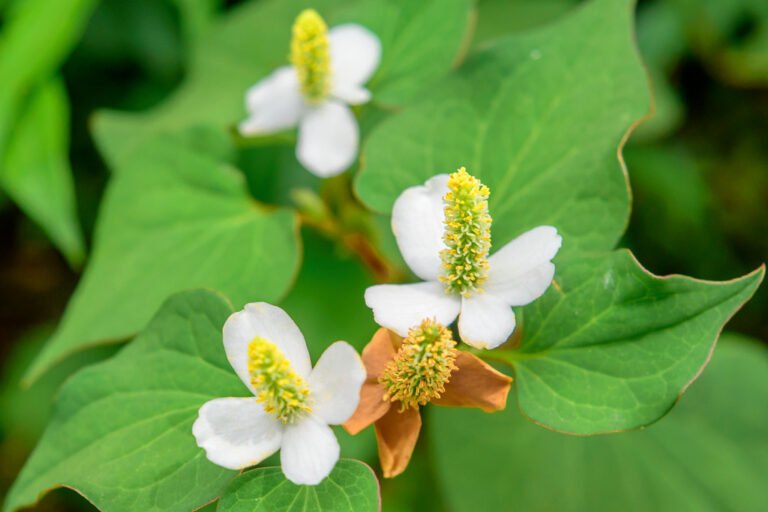Basil, Thai
Thai Basil, scientifically known as Ocimum basilicum var. thyrsiflora, showcases vibrant glossy leaves exuding an enticing anise fragrance with delicate hints of licorice. A prized element in Southeast Asian culinary creations, this herb enhances dishes with its aromatic essence. Rich in antioxidants and essential oils such as eugenol and linalool, Thai basil contributes potential health benefits. Its versatility ranges from being an indispensable component in curries and salads to innovative uses like infusing oils or cocktails. If intrigued by this aromatic herb, explore its full range of culinary, health, and growing insights in further investigation.
Overview of Thai Basil
Thai basil, also known as Ocimum basilicum var. thyrsiflora, stands out as a key herb in the vibrant cuisines of Southeast Asia. Its distinctive shiny green leaves, slightly serrated and narrow, release a sweet aroma with notes of anise and hints of licorice. This particular variety of basil is an essential ingredient in dishes like green curry, a signature Thai dish where its unique flavor shines through. The use of Thai basil in culinary creations adds an aromatic depth that sets it apart from other basil varieties.
In the culinary landscape of Thailand, Thai basil plays a significant role in enhancing the flavors of various dishes. The herb’s aromatic leaves are commonly used to infuse a distinct flavor into traditional Thai curries, where its fresh and slightly peppery taste complements the rich and spicy elements of the dish. Its inclusion in green curry, a popular Thai dish, not only adds a burst of freshness but also offers a subtle licorice-like undertone that balances the overall flavor profile.
Furthermore, the bright green color of Thai basil leaves adds visual appeal to dishes, making them not only flavorful but also visually appealing. Its versatility extends beyond curry dishes, as it is also used as a garnish or mixed into salads, imparting a revitalizing herbal note to the overall culinary experience.
Health Benefits of Thai Basil
Thai basil’s impressive array of antioxidants, such as eugenol, provides anti-inflammatory benefits and cellular protection. The essential oils found in Thai basil, like estragole and linalool, not only give it its aromatic charm but also contribute to potential health advantages. Rich in vitamins A and K, along with minerals like manganese and calcium, Thai basil supports various bodily functions and overall well-being.
Nutritional Value Overview
Rich in antioxidants and essential oils, Thai basil offers a range of potential health benefits that support overall well-being. The antioxidants present in Thai basil, such as eugenol, may help protect cells from damage and reduce inflammation, providing a protective shield for the body. Essential oils like estragole and linalool not only give Thai basil its distinctive aroma but also contribute to its potential health advantages. This herb is a good source of vitamin K, important for bone health and blood clotting mechanisms. Additionally, Thai basil provides essential minerals like iron, calcium, and magnesium, which play important roles in various bodily functions. Its digestion-promoting compounds can aid in gut health and alleviate digestive discomfort, making it a valuable addition to dishes like fried rice, chicken dumplings, or simply as fresh basil leaves in salads.
Culinary Uses and Tips
With its distinct anise-like flavor and versatile culinary applications, Thai basil stands out as a prominent herb in Southeast Asian cuisines. Thai basil is commonly used in Thai curries, sanbeiji, and Vietnamese dishes as a flavorful condiment. In Western cooking, it’s a popular substitute for holy basil, enhancing traditional Thai recipes like phở and bún bò Huế. Raw Thai basil leaves are served as a side for Vietnamese dishes, adding a fresh and aromatic seasoning. To maintain its flavor, regular harvesting is essential, promoting regrowth and preventing bitterness in the leaves. Thai basil pairs well with ingredients like chili, garlic, lemongrass, and coconut milk, making it a versatile herb in various cooking techniques such as stir-fries, soups, and salads.
Medicinal Properties Explored
Exploring the medicinal properties of Thai basil reveals a plethora of health benefits, from antioxidant-rich compounds to potential anti-inflammatory and antibacterial effects. Thai basil, a trove of herbal remedies, contains essential oils, antioxidants, vitamins A, and C, renowned for their immune-boosting properties. Studies suggest that this herb’s compounds offer healing properties, aiding in wound recovery and reducing inflammation. The eugenol present in Thai basil is believed to possess pain-relieving attributes, potentially alleviating headaches and migraines. Rich in magnesium, iron, and calcium, Thai basil contributes to bone health, muscle function, and overall well-being. Its fiber content and gut-friendly compounds also support digestive health, making it an herb with therapeutic benefits worth exploring.
Culinary Uses of Thai Basil
Thai basil, Ocimum basilicum var. thyrsiflora, boasts a unique anise-like flavor that enriches various dishes. Cooking with Thai basil infuses a vibrant aroma and a invigorating taste into culinary creations. Pairing this herb with spicy dishes, curries, stir-fries, and even desserts can enhance the overall flavor profile with its distinct notes.
Flavorful Thai Basil
What unique flavors does Thai basil contribute to Southeast Asian dishes, distinguishing it from other herbs commonly used in the region?
- Thai basil cocktails: The aromatic notes of Thai basil infuse drinks with a invigorating and slightly spicy undertone, elevating the flavor profile of beverages like mojitos and margaritas.
- Thai basil pesto: When blended with garlic, nuts, Parmesan cheese, and olive oil, Thai basil creates a vibrant and herbaceous pesto sauce with a hint of licorice, perfect for pasta dishes or as a flavorful marinade.
- Thai basil infused oils: By steeping Thai basil leaves in oil, you can create a fragrant and versatile ingredient that can be drizzled over salads, pizzas, or used for dipping bread, enhancing dishes with its sweet and peppery essence.
Cooking With Thai Basil
Exploring the culinary versatility of Thai basil reveals its ability to impart a distinct anise-like essence to a wide array of Southeast Asian dishes. Thai basil adds a invigorating twist to beverages like Thai basil cocktails, infusing them with a fragrant and slightly spicy note. In terms of creating flavorful sauces, Thai basil pesto is a popular choice, blending the herb’s aromatic qualities with nuts, garlic, and olive oil for a vibrant sauce. Additionally, Thai basil can be used to make infused oil, which serves as a savory base for stir-fries or drizzling over dishes. The process involves steeping Thai basil leaves in oil to capture and preserve the herb’s unique flavor, enhancing the taste of various culinary creations.
Thai Basil Pairings
Enhancing culinary creations with its aromatic essence, Thai basil gracefully heightens dishes like green curry, stir-fries, and noodle soups, imparting a distinctive anise-like flavor profile. When considering Thai basil pairings, it’s essential to investigate a variety of options to fully appreciate its versatility in different culinary contexts:
- Thai basil cocktail pairings: Incorporate Thai basil into cocktails by muddling the leaves with ingredients like lime, cucumber, or lemongrass for a revitalizing herbal twist. It pairs exceptionally well with spirits like gin or vodka, adding a unique depth to beverages.
- Thai basil dessert combinations: Experiment with Thai basil-infused syrups in desserts like panna cotta, sorbets, or fruit salads. The herb’s sweet and slightly spicy notes can enhance the flavor profile of sweet treats, creating a harmonious balance of taste.
- Thai basil infusion techniques: Investigate infusion techniques by steeping Thai basil in simple syrup, vinegar, or oil to extract its aromatic oils for use in dressings, marinades, or drizzles. This process enriches the herb’s flavor, allowing it to permeate dishes thoroughly.
Growing Thai Basil at Home
Growing Thai Basil at home involves providing ideal growing conditions such as well-draining soil with a pH of 6.5 to 7.5 and ensuring the plant receives 6 to 8 hours of sunlight daily. For container gardening, choose a pot with good drainage to prevent waterlogging, which can lead to root rot. Indoor cultivation can be successful with the right techniques; consider placing the plant near a sunny window or using grow lights to supplement sunlight.
Sunlight requirements are vital for the care of Thai Basil. Place your plant in a spot that receives direct sunlight for at least 6 hours a day, as insufficient light can result in leggy growth and diminished flavor. When growing indoors, rotate the plant occasionally to make sure all sides receive equal sunlight exposure.
To promote leaf production and prevent the plant from turning bitter, pinch off any flower buds that appear. Regular harvesting encourages the plant to grow more leaves, providing a fresh supply for culinary use. Thai basil is a versatile herb with an anise-like flavor, commonly used in Southeast Asian cuisines. By following these tips and techniques, you can successfully grow Thai Basil at home for an abundant and flavorful harvest.
Thai Basil in Southeast Asian Cuisines
In Southeast Asian cuisines, Thai basil plays a significant role as a key ingredient known for its distinct anise-like flavor. The herb is a staple in Thai, Vietnamese, Lao, and Cambodian dishes, enhancing the overall taste profile with its aromatic and slightly spicy notes. Here are some ways Thai basil is utilized in these culinary traditions:
- Thai Basil Cocktails: In Southeast Asia, Thai basil is not limited to savory dishes; it also finds its way into invigorating beverages. Cocktails infused with Thai basil offer a unique twist, combining the herb’s peppery undertones with the sweetness of the drink for a delightful flavor profile.
- Thai Basil Infused Oils: Extracting the essence of Thai basil into oils is a common practice in Southeast Asian kitchens. These infused oils add a fragrant touch to stir-fries, salads, and marinades, elevating the dish with a hint of herbal complexity.
- Thai Basil Pesto Variations: While traditional Italian pesto features basil varieties like sweet basil, Thai basil brings a new dimension to pesto sauces in Southeast Asian cuisines. The herb’s licorice-like taste blends harmoniously with garlic, nuts, and Parmesan cheese, creating a vibrant and aromatic pesto that pairs beautifully with noodles, grilled meats, or as a dipping sauce.
Flavor Profile of Thai Basil
With its sweet, anise-like scent and subtle hints of licorice, Thai basil distinguishes itself among the various basil varieties commonly used in Southeast Asian cuisines. This aromatic herb not only adds a unique flavor to dishes but also offers a visually appealing addition with its vibrant green leaves and purple-hued stems. Thai basil thrives in warm, sunny conditions and benefits from well-drained soil, making it important to keep these growing techniques in mind for a successful harvest.
The aromatic qualities of Thai basil are what make it a sought-after ingredient in culinary circles. The combination of sweetness and licorice undertones adds depth to dishes, enhancing the overall flavor profile. When used in cooking, the essential oils released from the leaves infuse the dish with a delightful fragrance that is characteristic of Thai cuisine.
In terms of culinary pairings, Thai basil shines in a variety of dishes. It is a staple in Thai curries, where its distinct flavor cuts through the richness of coconut milk. Additionally, Thai basil complements stir-fries, noodle dishes, and salads, adding a burst of freshness and flavor. Its versatility extends to beverages and desserts, where it can be used to infuse syrups or garnish sweet treats, offering a unique twist to traditional recipes.
Cooking Tips With Thai Basil
An essential aspect to keep in mind when utilizing Thai basil in cooking is maximizing its aromatic properties to enhance the overall flavor profile of dishes. Thai basil’s unique flavor is a versatile addition to various culinary creations. Here are some cooking tips to make the most of this herb:
- Thai Basil Cocktails: Infuse Thai basil into simple syrups or muddle it with other herbs and fruits to create invigorating cocktails. The herb’s peppery undertones and sweet aroma can complement the flavors of drinks like mojitos, margaritas, or even a unique Thai basil gin and tonic.
- Thai Basil Desserts: Experiment with incorporating Thai basil into desserts for a surprising twist. Consider adding chopped Thai basil leaves to ice cream, sorbets, or fruit salads. The herb’s slightly spicy and licorice-like notes can provide a delightful contrast to sweet treats, enhancing the overall taste experience.
- Thai Basil Infused Oils: Make your own Thai basil-infused oil to drizzle over salads, pasta dishes, or grilled vegetables. The process involves gently heating a neutral oil like grapeseed or olive oil with Thai basil leaves to extract the herb’s essence. This aromatic oil can enhance the flavors of various dishes, adding a hint of Thai basil’s distinctive taste.




